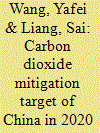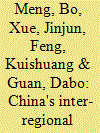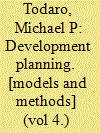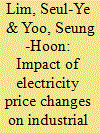|
|
|
Sort Order |
|
|
|
Items / Page
|
|
|
|
|
|
|
| Srl | Item |
| 1 |
ID:
029636


|
|
|
|
|
| Publication |
London, North - Holland Publishing company, 1972.
|
| Description |
viii, 600p.
|
|
|
|
|
|
|
|
|
|
|
|
Copies: C:1/I:0,R:0,Q:0
Circulation
| Accession# | Call# | Current Location | Status | Policy | Location |
| 011478 | 339.23/INP 011478 | Main | On Shelf | General | |
|
|
|
|
| 2 |
ID:
115160


|
|
|
|
|
| Publication |
2012.
|
| Summary/Abstract |
Based on the input-output model and the comparable price input-output tables, the current paper investigates the indirect carbon emissions from residential consumption in China in 1992-2005, and examines the impacts on the emissions using the structural decomposition method. The results demonstrate that the rise of the residential consumption level played a dominant role in the growth of residential indirect emissions. The persistent decline of the carbon emission intensity of industrial sectors presented a significant negative effect on the emissions. The change in the intermediate demand of industrial sectors resulted in an overall positive effect, except in the initial years. The increase in population prompted the indirect emissions to a certain extent; however, population size is no longer the main reason for the growth of the emissions. The change in the consumption structure showed a weak positive effect, demonstrating the importance for China to control and slow down the increase in the emissions while in the process of optimizing the residential consumption structure. The results imply that the means for restructuring the economy and improving efficiency, rather than for lowering the consumption scale, should be adopted by China to achieve the targets of energy conservation and emission reduction.
|
|
|
|
|
|
|
|
|
|
|
|
|
|
|
|
| 3 |
ID:
122740


|
|
|
|
|
| Publication |
2013.
|
| Summary/Abstract |
As the capital of China, Beijing is regarded as a major metropolis in the world. Study of the variation in temporal CO2 emissions generated by the driving forces in Beijing can provide guidance for policy decisions on CO2 emissions mitigation in global metropolises. Based on input-output structural decomposition analysis (IO-SDA), we analysed the driving forces for the increment in CO2 emissions in Beijing from both production and final demand perspectives during 1997-2010. According to our results, the CO2 emission growth in Beijing is driven mainly by production structure change and population growth, partly offset by CO2 emission intensity reduction as well as the decline in per capita final demand volume during the study period. Final demand structure change has a limited effect on the change in the CO2 emissions in Beijing. From the final demand perspective, urban trades, urban residential consumption, government consumption and fixed capital formation are mainly responsible for the booming emissions. This study showed how the "top-down" IO-SDA methodology was implemented on a city scale. Policy implications from this study would be helpful for addressing CO2 emissions mitigation in global capital cities and metropolises.
|
|
|
|
|
|
|
|
|
|
|
|
|
|
|
|
| 4 |
ID:
122718


|
|
|
|
|
| Publication |
2013.
|
| Summary/Abstract |
China proposed a CO2 mitigation target in 2020 to deal with anthropogenic global climate change. Chinese policy makers mainly focus on three factors comprising consumption structure changes, energy technology development, and new energy increments. In addition, sectoral CO2 reduction is increasingly concerned in the world. Thus, it is significant to investigate integrated impacts of three factors to China's CO2 mitigation target as well as to identify key economic sectors for achieving this target. In this study, energy demand and CO2 emission in 2020 are predicted. Five scenarios are generated to illustrate the contributions of three factors. In addition, twelve key economic sectors for reducing energy demand and CO2 emission are identified from both production and final demand perspectives. Under integrated impacts of three factors, China's CO2 intensity per unit gross domestic product in 2020 will decrease by about 43.9% in 2020 than 2005 level. In the short term, China's CO2 mitigation will be highly dependent on energy technology development. In the long term, it will mainly rely on reshaped consumption structure changes and new energy development. In addition, China's future policies should focus on 12 identified key economic sectors.
|
|
|
|
|
|
|
|
|
|
|
|
|
|
|
|
| 5 |
ID:
125650


|
|
|
|
|
| Publication |
2013.
|
| Summary/Abstract |
In this study, we apply the inter-regional input-output model to explain the relationship between China's inter-regional spillover of CO2 emissions and domestic supply chains for 2002 and 2007. Based on this model, we propose alternative indicators such as the trade in CO2 emissions, CO2 emissions in trade and the regional trade balances of CO2 emissions. Our results do not only reveal the nature and significance of inter-regional environmental spillover within China's domestic regions but also demonstrate how CO2 emissions are created and distributed across regions via domestic and global production networks. Results show that a region's CO2 emissions depend on its intra-regional production technology, energy use efficiency, as well as its position and participation degree in domestic and global supply chains.
|
|
|
|
|
|
|
|
|
|
|
|
|
|
|
|
| 6 |
ID:
110430


|
|
|
|
|
| Publication |
2011.
|
| Summary/Abstract |
This study examines the annual CO2 emissions embodied in China's exports from 2002 to 2008 using environmental input-output analysis. Four driving forces, including emission intensity, economic production structure, export composition, and total export volume, are compared for their contributions to the increase of embodied CO2 emissions using a structural decomposition analysis (SDA) technique. Although offset by the decrease in emission intensity, the increase of embodied CO2 emissions was driven by changes of the other three factors. In particular, the change of the export composition was the largest driver, primarily due to the increasing fraction of metal products in China's total export. Relevant policy implications and future research directions are discussed at the end of the paper.
|
|
|
|
|
|
|
|
|
|
|
|
|
|
|
|
| 7 |
ID:
109628


|
|
|
|
|
| Publication |
2011.
|
| Summary/Abstract |
To gain insight into changes in CO2 emissions embodied in China-US trade, an input-output analysis based on the emergy/dollar ratio (EDR) is used to estimate embodied CO2 emissions; a structural decomposition analysis (SDA) is employed to analyze the driving factors for changes in CO2 emissions embodied in China's exports to the US during 2002-2007. The results of the input-output analysis show that net export of CO2 emissions increased quickly from 2002 to 2005 but decreased from 2005 to 2007. These trends are due to a reduction in total CO2 emission intensity, a decrease in the exchange rate, and small imports of embodied CO2 emissions. The results of the SDA demonstrate that total export volume was the largest driving factor for the increase in embodied CO2 emissions during 2002-2007, followed by intermediate input structure. Direct CO2 emissions intensity had a negative effect on changes in embodied CO2 emissions. The results suggest that China should establish a framework for allocating emission responsibilities, enhance energy efficiency, and improve intermediate input structure.
|
|
|
|
|
|
|
|
|
|
|
|
|
|
|
|
| 8 |
ID:
110423


|
|
|
|
|
| Publication |
2011.
|
| Summary/Abstract |
Assessment of urban energy use may proceed by a number of methods. Here we derive an energy account from local statistics, and compare them with an input output (IO) analysis as applied to Melbourne, Australia. These approaches highlight different aspects of urban energy use and comparable outputs are presented together to assess consistency, to identify complementarities and discuss the insight each approach brings to understanding urban energy. The IO method captures the direct and embodied primary energy requirements of local household expenditure (235.8 GJ/capita/year) while the regional assessment more directly accounts for local production activity (258.1 GJ/capita/year). The parity of these results is unexpected for a developed city with a strong tertiary sector. Sectoral detail reveals differences between the primary energy required by Melbourne's economic structure and that ultimately required through the full supply chain relating to household expenditure. This is accompanied by an IO analysis of the geography of Melbourne's 'energy catchment'. It is suggested that the IO consumption and regional production approaches have particular relevance to policies aimed at consumption behaviour and economic (re)structuring, respectively. Their complementarity further suggests that a combined analysis would be valuable in understanding urban energy futures and economic transitions elsewhere.
|
|
|
|
|
|
|
|
|
|
|
|
|
|
|
|
| 9 |
ID:
040308


|
|
|
|
|
| Edition |
vol 4.
|
| Publication |
Nairobi, Oxford University Press, 1971.
|
| Description |
x,10p.
|
| Series |
Undergraduate teaching works in economics developed at Makerere University, Kampala
|
|
|
|
|
|
|
|
|
|
|
|
Copies: C:1/I:0,R:0,Q:0
Circulation
| Accession# | Call# | Current Location | Status | Policy | Location |
| 009530 | 338.954/TOD 009530 | Main | On Shelf | General | |
|
|
|
|
| 10 |
ID:
116509


|
|
|
|
|
| Publication |
2012.
|
| Summary/Abstract |
We develop an input-output methodology to estimate how Chinese exports affected the country's total domestic value added (DVA) and employment in the years 2002 and 2007. For every US$1000 dollar of Chinese exports in 2007 (2002), DVA and employment are estimated to be US$591 (US$466) and 0.096 (0.242) person-year, respectively. To implement these estimations, we use hitherto unpublished Chinese government data to construct several completely new datasets, including an input-output table with separate input-output and employment-output coefficients for processing exports, non-processing exports, and output for domestic use. We hypothesize that, in comparison with the export sector, China's domestic sector would be relatively autarkic due to China's history of central planning. We expect that exports would generate less DVA and employment than output for domestic use. Processing exports, which are highly dependent on imported inputs, would similarly generate less DVA and employment than non-processing exports. Our findings support these expectations. For both 2002 and 2007, the DVA and employment effects of domestic final demand were higher than those of non-processing exports, which were in turn higher than those of processing exports. However, with the progress of economic reforms, we found that the total DVAs of exports and domestic final demand have converged from 2002 to 2007.
|
|
|
|
|
|
|
|
|
|
|
|
|
|
|
|
| 11 |
ID:
097512


|
|
|
|
|
| Publication |
2010.
|
| Summary/Abstract |
Despite differences in their implementation, most carbon policies aim to have similar outcomes: effectively raising the price of carbon-intensive products relative to non-carbon-intensive products. While it is possible to predict the simple broad-scale economic impacts of raising the price of carbon-intensive products-the demand for non-carbon-intensive products will increase-understanding the economic and environmental impacts of carbon policies throughout the life cycle of both types of products is more difficult. Using the example of a carbon tax, this study proposes a methodology that integrates short-term policy-induced consumer demand changes into the input-output framework to analyze the environmental and economic repercussions of a policy. Environmental repercussions include the direct and the indirect impacts on emissions, materials flow in the economy, and the reliance on various ecosystem goods and services. The approach combines economic data with data about physical flow of fossil fuels between sectors, consumption of natural resources and emissions from each sector. It applies several input-output modeling equations sequentially and uses various levels of aggregation/disaggregation. It is illustrated with the data for the 2002 U.S. economy and physical flows. The framework provides insight into the short-term complex interactions between carbon price and its economic and environmental effects.
|
|
|
|
|
|
|
|
|
|
|
|
|
|
|
|
| 12 |
ID:
125838


|
|
|
|
|
| Publication |
2013.
|
| Summary/Abstract |
To address the climate change issue, developed nations have considered introducing carbon pricing mechanisms in the form of a carbon tax or an emissions trading scheme (ETS). Despite the small number of programmes actually in operation, these mechanisms remain under active discussion in a number of countries, including Japan. Using an input-output model of the Japanese economy, this article analyses the effects of carbon pricing on Japan's industrial sector. We also examine the impact of a rebate programme of the type proposed for energy-intensive trade-exposed (EITE) industries in U.S. legislation, the Waxman-Markey Bill (H.R. 2454), and in the European Union's ETS. We find that a carbon pricing scheme would impose a disproportionate burden on a limited number of sectors - namely, pig iron, crude steel (converters), cement and other EITE industries. Out of 401 industries, 23 would be eligible for rebates according to the Waxman-Markey-type programme, whereas 122 industries would be eligible for rebates according to the E.U.-type programme, if adopted in Japan. Overall, despite the differences in coverage, we find that the Waxman-Markey and E.U. rebate programmes have roughly similar impacts in reducing the average burden on EITE industries.
|
|
|
|
|
|
|
|
|
|
|
|
|
|
|
|
| 13 |
ID:
093535


|
|
|
|
|
| Publication |
2010.
|
| Summary/Abstract |
China is the world's largest emitter of carbon dioxide (CO2). As exports account for about one-third of China's GDP, the CO2 emissions are related to not only China's own consumption but also external demand. Using the input-output analysis (IOA), we analyze the embodied CO2 emissions of China's import and export. Our results show that about 3357 million tons CO2 emissions were embodied in the exports and the emissions avoided by imports (EAI) were 2333 million tons in 2005. The average contribution to embodied emission factors by electricity generation was over 35%. And that by cement production was about 20%. It implies that the production-based emissions of China are more than the consumption-based emissions, which is evidence that carbon leakage occurs under the current climate policies and international trade rules. In addition to the call for a new global framework to allocate emission responsibilities, China should make great efforts to improve its energy efficiency, carry out electricity pricing reforms and increase renewable energy. In particular, to use advanced technology in cement production will be helpful to China's CO2 abatement.
|
|
|
|
|
|
|
|
|
|
|
|
|
|
|
|
| 14 |
ID:
043261


|
|
|
|
|
| Publication |
Bombay, Somaiya Publications, 1970.
|
| Description |
xvi, 359p.
|
|
|
|
|
|
|
|
|
|
|
|
Copies: C:1/I:0,R:0,Q:0
Circulation
| Accession# | Call# | Current Location | Status | Policy | Location |
| 004396 | 330./MEH 004396 | Main | On Shelf | General | |
|
|
|
|
| 15 |
ID:
121362


|
|
|
|
|
| Publication |
2013.
|
| Summary/Abstract |
The aim of this paper is twofold: first, to calculate the "green" energy investments, by industrial sector, that Greece would need in order to satisfy a number of energy and environmental targets adopted in the context of the European Commission's energy and climate change package; and second, to calculate the macro-economic impacts of these "green" investments on production and employment in the Greek economy. To this end, the input-output analysis has been exploited for estimating the direct, indirect and induced macroeconomic effects associated with the implementation of selected energy conservation measures, the promotion of renewable energy technologies, etc. Our findings show that the required investments would reach the amount of €47.9 billion, over the period 2010-2020. These investments will result in an average annual increase of the national product by €9.4 billion, creating simultaneously 108,000 full-time equivalent jobs for the entire period under consideration. The employment generated per €1 million investment is relatively higher in energy saving projects in buildings and transport in comparison with the development of RES in power generation sector.
|
|
|
|
|
|
|
|
|
|
|
|
|
|
|
|
| 16 |
ID:
125684


|
|
|
|
|
| Publication |
2013.
|
| Summary/Abstract |
Electricity has played an important role in the economic development of Korea and, thus, has become a critical factor in sustaining the well-being of the Korean people. This study attempts to investigate the impact of electricity price changes on industrial prices and the general price level using input-output (I-O) analysis. To this end, we apply the I-O price model to the 2011 I-O table recently produced by the Bank of Korea, paying particular attention to the electricity sector by considering it as exogenous and then investigating its impacts. The impacts of the electricity price changes on each industrial sector's prices and the general price level are quantitatively derived. For example, the overall impact of a 10% increase in electricity price on the Korean national economy is estimated to be 0.4367%. We also report the results from the model with the electricity sector endogenous and the model with endogenous electricity and labor sectors. This information can be usefully utilized in decision-making regarding price management for electricity.
|
|
|
|
|
|
|
|
|
|
|
|
|
|
|
|
| 17 |
ID:
125834


|
|
|
|
|
| Publication |
2013.
|
| Summary/Abstract |
Fossil fuel-related CO2 emissions are regarded as the primary sources of global climate change. Unlike direct CO2 emissions for each sector, CO2 emissions associated with complex linkages among sectors are usually ignored. We integrated the input-output analysis with the hypothetical extraction method to uncover the in-depth characteristics of the inter-sectoral linkages of CO2 emissions. Based on China's 2007 data, this paper compared the output and demand emissions of CO2 among eight blocks. The difference between the demand and output emissions of a block indicates that CO2 is transferred from one block to another. Among the sectors analyzed in this study, the Energy industry block has the greatest CO2 emissions with the Technology industry, Construction and Service blocks as its emission's primary destinations. Low-carbon industries that have lower direct CO2 emissions are deeply anchored to high-carbon ones. If no effective measures are taken to limit final demand emissions or adjust energy structure, shifting to an economy that is low-carbon industries oriented would entail a decrease in CO2 emission intensity per unit GDP but an increase in overall CO2 emissions in absolute terms. The results are discussed in the context of climate-change policy.
|
|
|
|
|
|
|
|
|
|
|
|
|
|
|
|
| 18 |
ID:
094304


|
|
|
|
|
| Publication |
2010.
|
| Summary/Abstract |
Under its Kyoto and EU obligations, Greece has committed to a greenhouse gas (GHG) emissions increase of at most 25% compared to 1990 levels, to be achieved during the period 2008-2012. Although this restriction was initially regarded as being realistic, information derived from GHG emissions inventories shows that an increase of approximately 28% has already taken place between 1990 and 2005, highlighting the need for immediate action. This paper explores the reallocation of production in Greece, on a sector-by-sector basis, in order to meet overall demand constraints and GHG emissions targets. We pose a constrained optimization problem, taking into account the Greek environmental input-output matrix for 2005, the amount of utilized energy and pollution reduction options. We examine two scenarios, limiting fluctuations in sectoral production to at most 10% and 15%, respectively, compared to baseline (2005) values. Our results indicate that (i) GHG emissions can be reduced significantly with relatively limited effects on GVP growth rates, and that (ii) greater cutbacks in GHG emissions can be achieved as more flexible production scenarios are allowed.
|
|
|
|
|
|
|
|
|
|
|
|
|
|
|
|
| 19 |
ID:
128407


|
|
|
|
|
| Publication |
2014.
|
| Summary/Abstract |
With an increase in China's oil imports, China's oil supply will also continue to be effected by the socio-economic stability of oil-exporting countries and the safety of oil transport routes. This paper introduces a systematic and quantitative method to evaluate the influence of China's oil import risks (OIR) on the national economy and industrial sectors from a perspective of apply chain process. For this analysis, China's OIR is quantified by integrating oil exporting country risk and the risks from oil transportation routes. Country risk is defined as the oil-exporting country's political risk caused by political changes or internal conflicts. Transport risk is defined as the risk of shipping routes affected by pirate attacks and geopolitics. Second, the relationship between China's OIR and oil import costs is analyzed using a multiple linear approach. Third, an input-output analysis method is used to research the effect of the cost of China's oil imports on the cost of investment within China's domestic sectors. This research finds that the corresponding impact on GDP is 3494.5 million dollars given an increasing by 10% of China's OIR. And the impact on domestic sectors differs from sector to sector. Finally, this paper puts forth recommendations to improve long-term oil supply security in China.
|
|
|
|
|
|
|
|
|
|
|
|
|
|
|
|
| 20 |
ID:
128411


|
|
|
|
|
| Publication |
2014.
|
| Summary/Abstract |
The decline of China's energy intensity slowed since 2000. During 2002-2005 it actually increased, reversing the long-term trend. Therefore, it is important to identify drivers of the fluctuation of energy intensity. We use input-output structural decomposition analysis to investigate the contributions of changes in energy mix, sectoral energy efficiency, production structure, final demand structure, and final demand category composition to China's energy intensity fluctuation during 1997-2007. We include household energy consumption in the study by closing the input-output model with respect to households. Results show that sectoral energy efficiency improvements contribute the most to the energy intensity decline during 1997-2007. The increase in China's energy intensity during 2002-2007 is instead explained by changes in final demand composition and production structure. Changes in final demand composition are mainly due to increasing share of exports, while changes in production structure mainly arise from the shift of Chinese economy to more energy-intensive industries. Changes in energy mix and final demand structure contribute little to China's energy intensity fluctuation. From the consumption perspective, growing exports of energy-intensive products and increasing infrastructure demands explain the majority of energy intensity increase during 2002-2007.
|
|
|
|
|
|
|
|
|
|
|
|
|
|
|
|
|
|
|
|
|